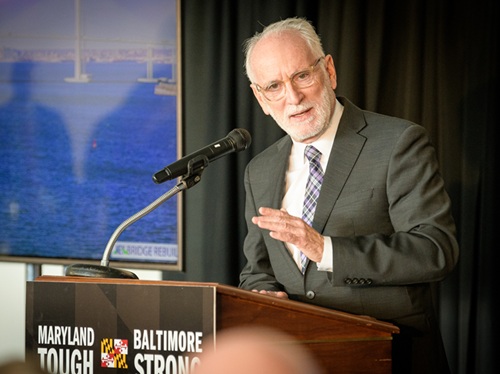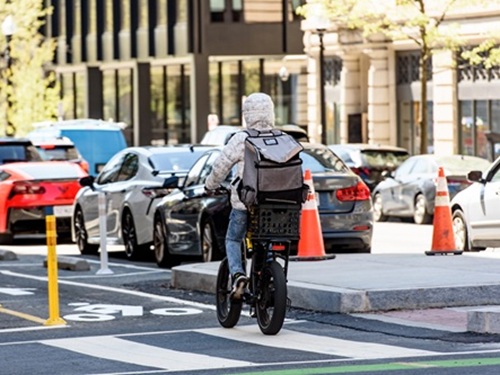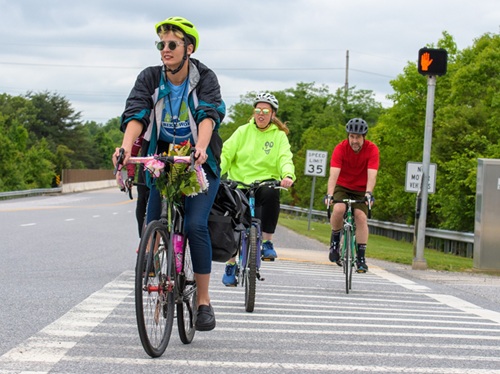The Maryland Department of Transportation recently released a final report on its “Complete Streets Leadership Academy,” set up during the summer of 2024 as a “technical assistance program” to test and evaluate roadway safety projects.
[Above photo by Maryland DOT]
A “Complete Street” is a roadway planned and designed to consider the safe, convenient access and mobility of roadway users of all ages and abilities. This includes pedestrians, bicyclists, public transportation users, and motorists; it includes children, the elderly, and persons with disabilities.
The Maryland DOT noted that its “Complete Streets Leadership Academy” – part of national program developed by Smart Growth America – included a series of workshops held last summer in several locales across Maryland to guide the installation of temporary road safety measures in Howard County, the City of Hagerstown, and the Town of Bel Air.
The agency then installed temporary or demonstration projects resulting from those workshops in the fall of 2024; projects targeting intersections or corridors with a known history of above average traffic fatalities or crashes. Maryland DOT said those projects were deployed in “record time,” going from concept to implementation in only three months, were cost effective relative to other safety interventions, and provided significant safety benefits.
For example, the Hagerstown project reduced average top speeds in the corridor by 15 percent and reduced the number of people going more than 20 mph over the speed limit by 90 percent; all taking place during a 20 percent increase in traffic volumes.

“[This] report marks an important milestone in how the department approaches safety issues,” said Paul Wiedefeld, Maryland DOT secretary, in a statement. “These quick-build demonstration projects will allow Maryland DOT to deploy near-term, cost-effective safety improvements, test their effectiveness, work with communities and make permanent the strategies that work.”
The Maryland DOT added that it implemented a “Complete Streets” policy in June 2024 that covers all the state transportation agencies under its purview, including the Maryland State Highway Administration, Maryland Transit Administration, Motor Vehicle Administration, Maryland Aviation Administration, Maryland Port Administration and the Maryland Transportation Authority.
Many state departments of transportation have adopted “Complete Street” policies over the last several years to help guide their road development activities.
For example, the Massachusetts Department of Transportation recently awarded more than $4.5 million to 11 municipalities as part of the first round of fiscal year 2025 grants via its Complete Streets Funding Program.
The agency said that those grants will fund local multimodal infrastructure projects that improve travel for pedestrians, public transit users, bicyclists and people using other forms of transportation.
MassDOT added that its Complete Streets Funding Program – launched in 2016 – provides technical assistance and construction funding to eligible municipalities to plan and implement Complete Streets. Prior to this latest round of disbursements, the program had awarded 278 construction project grants across the state worth more than $100 million in total.
In September 2023, the Connecticut Department of Transportation adopted “Complete Streets” design criteria that it incorporated into all of its surface roadway projects.
The agency said this new design criteria expands on its existing “Complete Streets” policy, which ensures that every roadway project includes a focus on pedestrian and bicyclist facilities and public transportation operations to create stronger intermodal transportation networks and improve safety.
In January 2023, Governor Kathy Hochul (D) signed a legislative package so the New York State Department of Transportation could boost support for municipal “Complete Streets” projects. That legislation increases the state share of funding for municipalities incorporating “Complete Streets” to 87.5 percent, which will help municipalities implement these street designs.
And in December 2021, the California Department of Transportation unveiled a new “Complete Streets” policy for all new transportation projects it funds or oversees in order to provide “safe and accessible options” for people walking, biking, and taking transit, while the South Carolina Department of Transportation put in place what it called a wide-ranging “Complete Streets” policy for the state-owned highway system in February 2021.
 States
States
Washington D.C. Launches E-Bike Food Delivery Pilot
July 18, 2025 States
States

